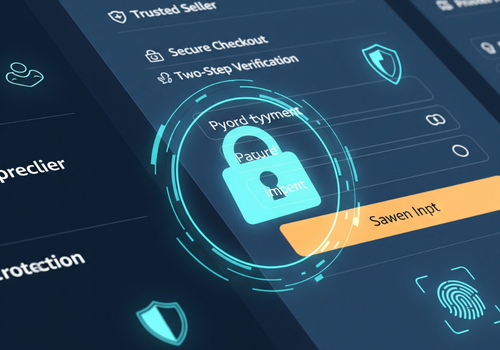Amazon Buyer Safety Tips for 2025: How to Avoid Scams, Spot Red Flags, and Protect Your Purchases
Know Who You’re Buying From: Seller Profiles Matter More Than Ever
In 2025, a major source of scams and counterfeit products stems from anonymous third-party sellers who pop up, sell thousands of fake or low-quality items, and disappear overnight. Before you buy anything, click on the seller’s name and examine their profile. Look for longevity (how long they’ve been active), customer reviews, and fulfillment method. Reputable sellers will have years of history, consistent high ratings, and products fulfilled by Amazon (FBA) or even sold directly by Amazon. Be cautious of sellers with little history or “just launched” tags, especially if the item is high-value.
Check for Red Flags in Product Listings Before You Buy
Scam listings often look polished — but several red flags can alert you to danger. Watch for over-the-top claims like “guaranteed results,” “FDA approved” (Amazon does not allow such claims), or “100% cure.” Read the product description carefully. If it’s vague, missing essential details, or filled with grammatical errors, it may not be legitimate. Look at the photos — authentic products will show detailed, branded packaging. Generic or AI-generated images with text overlays often suggest fakes or unauthorized resellers. If you spot stock photos with no actual product shown, steer clear.
Use Verified Reviews and External Tools to Avoid Being Misled
Fake reviews are still a massive issue on Amazon in 2025. Many sellers manipulate their ratings with incentivized or bot-generated reviews. Always prioritize Verified Purchase reviews and filter for the most recent ones. Look for patterns — do multiple reviewers complain about damaged goods, expired items, or incorrect packaging? Use review analysis tools like Fakespot or ReviewMeta to assess authenticity. These tools can help you decode whether the glowing feedback is genuine or artificially inflated. Trustworthy products will show consistency across platforms, not just Amazon.
Stick to Fulfilled-by-Amazon (FBA) or Sold-by-Amazon Listings When Possible
Choosing products that are either Sold by Amazon or Fulfilled by Amazon adds an extra layer of buyer protection. These listings ensure that the product is stored, shipped, and often inspected by Amazon staff — reducing the chances of tampering or counterfeit. It also makes returns and refunds easier through Amazon’s customer service policies. While this isn’t foolproof, it’s safer than buying directly from third-party sellers with independent shipping processes, where fraud and delays are more likely.
Know the Signs of a Scam Seller in 2025
Scam sellers use several tricks to manipulate Amazon’s system. Common signs include drastically low prices compared to competitors, urgent sales copy (like “Only 1 left in stock!”), strange brand names, and product titles packed with keywords but little real information. If the deal seems too good to be true, it probably is. Many scam sellers also exploit temporary loopholes by changing product categories or ASINs to avoid detection. Always do a quick web search of the brand to verify its existence before checking out.
Understand Your Protection Under Amazon’s A-to-Z Guarantee
Amazon offers the A-to-Z Guarantee, which protects you when buying from third-party sellers. If you receive a damaged item, wrong product, or nothing at all — and the seller doesn’t resolve it — Amazon may refund you directly. But this protection isn’t automatic. You must contact the seller first, wait a required period (usually 48 hours), and then file a formal claim. Be sure to keep screenshots, shipping confirmations, and messages to support your case. Many buyers lose money because they don’t follow the correct process or wait too long to file.
Enable Notifications and Keep Track of Your Deliveries in Real Time
One of the best safety strategies in 2025 is proactive order tracking. Enable Amazon Delivery Notifications via the app and email. Monitor tracking updates and cross-check the delivery timeline with the listing’s estimated delivery date. If you notice delays, contact Amazon immediately. Scammers often mark packages as “delivered” when they haven’t shipped anything at all. Regular tracking helps you catch issues before it’s too late to request a refund or replacement.
Be Cautious of Lightning Deals and Limited-Time Offers
Flash sales and lightning deals can pressure you to buy quickly — but they’re also used by scam sellers to unload questionable inventory before Amazon shuts down their listing. Always take an extra minute to verify seller ratings and reviews before completing a purchase under time pressure. High-urgency offers are a common tactic to suppress your judgment and get you to overlook red flags.
Check Product Certification and Legitimacy, Especially for Health and Electronics
For items like dietary supplements, cosmetics, or electronics, safety certifications are critical. Look for indicators like GMP, FDA-registered facility, CE, FCC, or UL-certified markings. Legitimate brands will proudly display these in their product images and description. If certification claims are vague or not supported with visual proof, be wary. In 2025, there are still countless unsafe and unregulated products slipping through Amazon’s listings, especially from unknown international sellers.
Conclusion: Protect Your Money and Your Trust with Smarter Shopping in 2025
Amazon shopping in 2025 is more powerful — and riskier — than ever. As a buyer, you have access to millions of products, but you also face scams, unsafe goods, and deceptive sellers hiding behind professional-looking listings. By practicing smart buying habits, learning to verify sellers and products, understanding the tools at your disposal (like the A-to-Z Guarantee and review analyzers), and staying alert for red flags, you can avoid most of the pitfalls shoppers fall into daily. Buyer safety isn’t about fear — it’s about informed confidence. And in 2025, that’s the most valuable thing you can have while shopping online.

